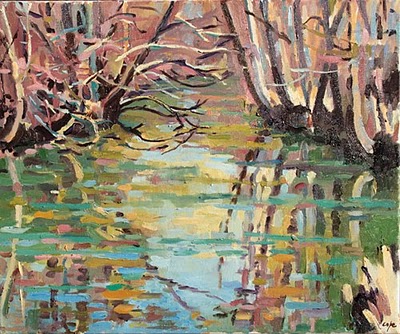Concernant la Destruction de la Ripisylve de la Riviére Dropt dans les Cantons de Villeréal, Castillonnès et Eymet.
oil on canvas
46 x 38 cm
© adam cope
These trees will be destroyed in next winter. 2011.
Condemned beings. Death row, the calmness of the alders, ashes & poplars unaware.
NO SPACE FOR NATURE IN THE COUNTRYSIDE ?


The Dropt at St.Dizier before & after the cutting in winter 2009
BEFORE THE DESTRUCTION OF 2010

‘Berges du Dropt, St.Dizier’
38 x 46 cm
oil on canvas
2006
©adam cope
SAME SPOT (looking downriver) AFTER THE DESTRUCTION OF 2010
POSTSCRIPT 2013
Some of the coppices have grown back, not all. The plot on the left hand side of the river is now entire grubbed out. No more nightingales nor deer. Some regeneration. the canton is now replanting with a budget of 7200 euros… funny old world. The upside is that no flooding has occurred these last years, even if the wild life is dying. I hope teh land can regenerate & reclaiming it’s biodiversity
after we’ve gone
we shall be litter and leaves
– a lyrebird’s song
Harry Laing , ‘Forest Meditations’
[button color=”green” size=”medium” align=”center” link=”https://www.artists-atelier.com//paintings/trees”]paintings of trees[/button]
>>>>>>>>>>>>>>>>>>>>>>>>>>>>>>>>
Machines have great power to sculpt the landscape. But what type of landscape are we making?
A square mile field without hedges? How much more public money via agricultural subsidies will be spent on this?
No space for nature in the countryside…. pretty isn’t it?
“Contempt for Small Places, Minor Destructions Add Up” – WENDELL BERRY
A GREEN CORRIDOR
The basic idea of a green corridor is to leave a corridor through which animals can migrate from one safe place to another. Good for nature, good for tourism, good for the soul.
A well preserved riparian strip on a tributary to Lake Erie.
riparian zone – wiki
‘L’Esperance’
oil on canvas
©adam cope
Sold
The banks of the river Dordogne are a classified nature reserve: Natura 2000, part of the European government’s legislation to protect nature. The banks of the river Dropt are also classified down river from Allemans sur Dropt, just after Eymet. https://natura2000.ecologie.gouv.fr/sites/FR7200692.html
The basic idea of a green corridor is to leave a corridor through which animals can migrate from one safe place to another. It also has the happy advantage that humans can walk or canoe along these passages. This is very good for tourism, which is the second economic activity of the Dordogne department & IMO, would become more important for the Lot & Garonne if the people in power had a better vision of how they take care of nature.
” Great problems call for many small solutions.” – Wendell Berry
NO SPACE FOR NATURE IN THE COUNTRYSIDE?
OF NATURE RESERVES & SUPERMARKET CONSUMPTION
“In Human culture lies the preservation of wildness.” – Wendell Berry
“The question we must deal with is not whether the domestic and the wild are separate or can be separated; it is how, in the human economy, their indissoluble and necessary connection can be properly maintained.” Wendell Berry For Love of the Land, Sierra magazine, May/June 2002
“The awareness that we are slowly growing into now is that the earthly wildness that we are so complexly dependent upon is at our mercy. It has become, in a sense, our artifact because it can only survive by a human understanding and forbearance that we now must make. The only thing we have to preserve nature with is culture; the only thing we have to preserve wildness with is domesticity.
“To me, this means simply that we are not safe in assuming that we can preserve wildness by making wilderness preserves. Those of us who see that wildness and wilderness need to be preserved are going to have to understand the dependence of these things upon our domestic economy and our domestic behavior. If we do not have an economy capable of valuing in particular terms the durable good of localities and communities, then we are not going to be able to preserve anything. We are going to have to see that, if we want our forests to last, then we must make wood products that last, for our forests are more threatened by shoddy workmanship than by clear-cutting or by fire. Good workmanship–that is, careful, considerate, and loving work–requires us to think considerately of the whole process, natural and cultural, involved in the making of wooden artifacts, because the good worker does not share the industrial contempt for ‘raw material.’ The good worker loves the board before it becomes a table, loves the tree before it yields the board, loves the forest before it gives up the tree. The good worker understands that a badly made artifact is both an insult to its user and a danger to its source. We could say, then, that good forestry begins with the respectful husbanding of the forest that we call stewardship and ends with well-made tables and chairs and houses, just as good agriculture begins with stewardship of the fields and ends with good meals.”
– Exerpt from ‘Home Economics’ by Wendell BERRY
“…. the great causes of agrarianism and conservation, despite local victories, have suffered an accumulation of losses, some of them probably irreparable-while the third side, that of the land-exploiting corporations, has appeared to grow ever richer.” —For Love of the Land by Wendell Berry
Futher Reading:
Natura 2000
European Union Water Framework Directive
A green corridor.
Une trame verte
Wendell Berry
For Love of the Land by Wendell Berry
Contempt for Small Places Minor Destructions Add Up – WENDELL BERRY
Read more in this blog in the artists & ecology categories.









